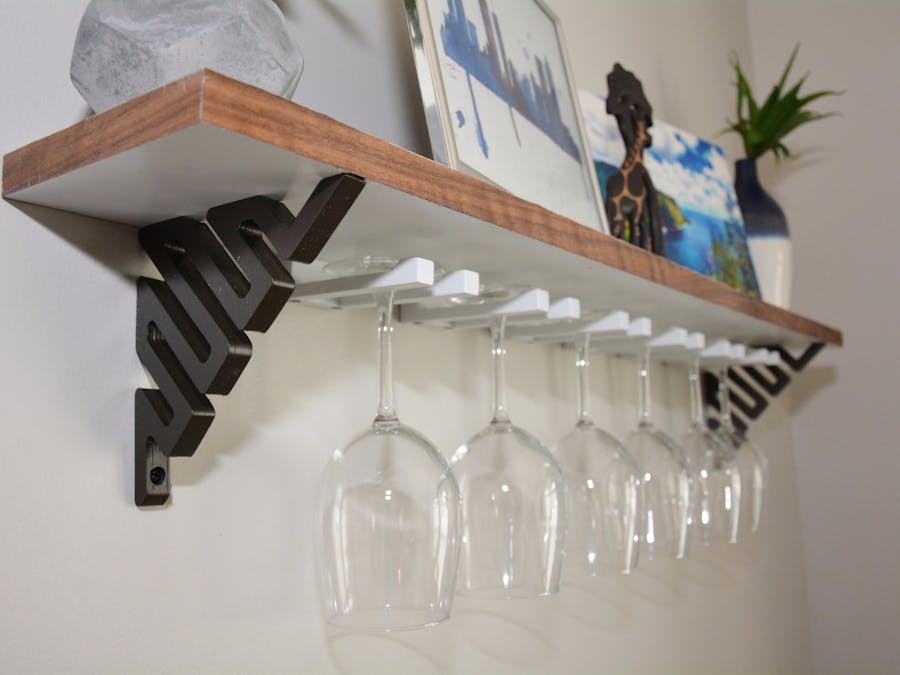This build gives you the option to easily upgrade an existing shelf in your home to add brackets to hang wine glasses OR a full DIY build including the shelf brackets and shelf. These instructions will be split into two so you can easily follow the desired option - the full DIY build will be posted here but the abbreviated instructions for upgrading an existing shelf are available to download below. No specialized tools are required and a 3D printer is not required - you can utilize a print service such as 3DHubs.com to obtain the 3D printed parts from a local printer. If you do not have a saw to cut the wood, you should be able to ask your hardware store to make the necessary cuts when purchasing the wood.
What You Will NeedMaterials:
- Walnut Wood Veneer ~$13
- Linseed Oil ~$6
- Sanding Paper ~$4
- 3D Printed Wine Glass Brackets (Quantity will be determined by the amount of shelf space)
Tools:
- Clothes Iron ~$22
- Orbital Sander (optional) ~$27
***Links provided are affiliate links if used to purchase something may provide Adylinn Studio a small commission.
3D Printed PartsIf you are sourcing your 3D printed parts, I’d suggest a local printer on 3D Hubs so you can pick up your printed pieces without having to risk shipping. Be sure to communicate the below settings when placing your order:
Shelf Brackets (decent surface quality to limit amount of sanding needed)
- Strong filament like ABS is recommended.
- 0.2mm layer height
- 70-80% infill
- No support
- Brim optional
Wine Glass Brackets (decent surface quality to limit amount of sanding needed)
- Filament choice not really important
- 0.2mm layer height
- 20-30% infill
- Orientation - thick/back end on build platform with brackets standing straight up.
- No support
- Brim optional
- Sand all the printed parts to the desired smoothness. Start with 120 grit and move up to 320 grit for a nicely smooth part without visible print lines.
- Wipe the sanded parts with a lightly damp cloth or paper towel.
- Once the parts are dry, evenly apply primer.
- Once the primer has dried, sand lightly. Wipe the sanded parts with a lightly damp cloth or paper towel.
- Paint brackets with desired color. For this build a matte white was used for the glass brackets and then a metallic bronze paint was used for the shelf brackets. Two coats is recommended.
- After the paint has had enough time to dry, apply clear coat.
- I recommend using a piece of MDF or plywood that is 3/4” thick, the depth should be 5 5/8” and it does not matter the length. I used 36” which allowed plenty of space for 6 wine glasses.
- Plan in advance where you want your mounting shelf brackets to be as you will need to cut out small notches for the shelf to sit.
- Sand the wood to desired smoothness. Use a damp cloth or paper towel to remove any dust.
- Prime the shelf on both sides - edges are do not need to be painted.
- Lightly sand the shelf once the primer has dried. Use a damp cloth or paper towel to remove any dust.
- Paint both sides with two coats.
- Measure out and mark up where the brackets will be installed (both the shelf brackets and the wine glass brackets) and where the notches will be cut. For a 36” long shelf there was 30” between the 2 shelf brackets. If you desire to install the shelf brackets into a stud 30” may not work.
- Pre-drill holes in the shelf for the wine glass brackets by using a wine glass bracket as a guide.
- Cut out notches in the shelf (2 per side) for the shelf to sit on the brackets. I used a combination of a drill and a razor blade. This does not need to be very precise as it should be fully covered by the bracket.
- Pre-cut the three strips of wood veneer for all sides of the shelf (do not need a strip for the back that will be against the wall).
- Before using Clothes Iron remove any water and allow clothes iron to dry.
- Heat up a clothes iron on the cotton setting. (Warning - some residue from the process may get on heat plate, though this did not happen during my build)
- Place the veneer strip on the side of the shelf.
- Use iron to melt adhesive, allowing it to stick to the shelf. The general speed to avoid scorching wood is 2 inches per second.
- Apply veneer to the other side and then finally finish with the front strip. Doing it in this order should avoid any visible seam from the front of the shelf.
- Because the strips are thicker than the wood, use a box cutter/razer blade to remove any overhanging material. Use the shelf to keep the blade straight.
- Apply a generous amount of linseed oil to veneer.
- Let oil sit and penetrate wood for roughly 10 minutes.
- Wipe any excess oil from veneer.
- Finally clear coat the entire shelf and the wood veneer.
- Glue is not necessary but you can optionally apply glue to each wine glass bracket before screwing them into the shelf.
- Screw in all wine glass brackets using the pre-drilled holes to line up the brackets.
- Measure and mark where the shelf brackets will be placed. Make sure the brackets when mounted on the wall will match up the notches you cut into the shelf in an earlier step.
- Mounting the brackets into a stud is not necessary but recommended if anything heavy will be placed on shelf. I simply used drywall screws as the weight on top of the shelf would be very minimal.
- Once the shelf brackets are installed you should be able to simply place the shelf on top of the brackets and the notches should allow the shelf to sit securely.
- Hang your wine glasses and enjoy your DIY Wine Glass Shelf!
Thanks for checking out the DIY Wine Glass Shelf build! If you enjoyed it, I post monthly builds using 3D printing on my website, https://www.adylinn.com/builds/.







Comments
Please log in or sign up to comment.